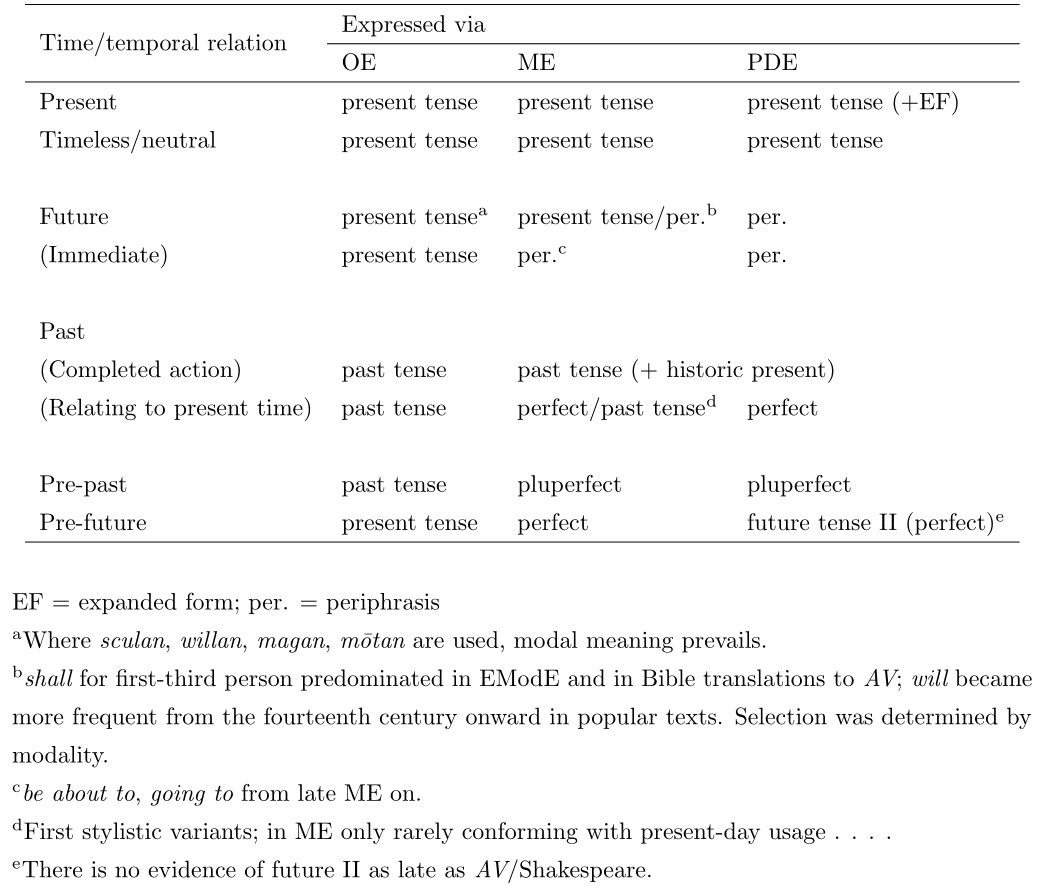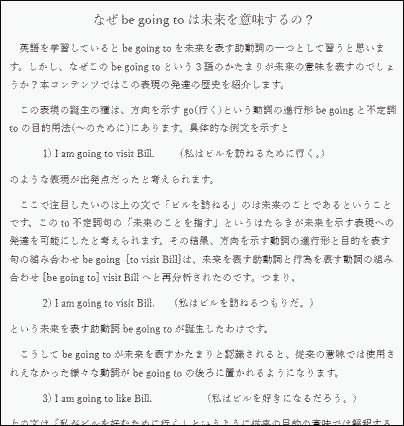2025-06-02 Mon
■ #5880. 時制の定義 [tense][category][preterite][future][verb][terminology][aspect][mood][inflection][periphrasis]
昨日の記事「#5879. 時制の一致を考える」 ([2025-06-01-1]) で時制 (tense) に関連する話題を取り上げた.また,かつて「#3693. 言語における時制とは何か?」 ([2019-06-07-1]) で時制について考えたこともある.
改めて時制とは何なのだろうか.手元にある International Encyclopedia of Linguistics で TENSE を引いてみた.定義をみてみよう (223--24) .
Definition
Tense refers to the grammatical expression of the time of the situation described in the proposition, relative to some other time. This other time may be the moment of speech: for example, the past and future designate time before and after the moment of speech, respectively, while the perfect (or anterior) designates past time which is relevant to the moment of speech. Or it may be some other reference time, as in the past perfect, which signals a time prior to another time in the past---as in I had just stepped into the shower when the phone rang, where the first clause signals a time prior to that of the second. The most commonly occurring tenses are past and future; however, perfect tenses are also common, as are combinations of perfect with past and future. Some languages show degrees of remoteness in the past or future: distinctions are possible between past situations of today vs. yesterday, yesterday vs. preceding days, or recent time vs. remote time. Analogous distinctions are possible in the future but not as common. Tense is expressed by inflections, by particles, or by auxiliaries in construction with the verb; it is rarely expressed by derivational morphology . . . .
では,その時制がいかにして言語上に表現されるのか (224) .
Expression
According to the traditional view, tense is a verbal inflectional category expressing time; however, the possibility of tense being realized also by periphrastic constructions is usually acknowledged. There are several difficulties in applying this view to actual languages. First, the semantics of many inflectional categories contain aspectual and modal as well as temporal elements: e.g., perfective aspect in many languages is restricted to past time reference, and future tenses almost always have modal overtones. Furthermore, if a language has several tense distinctions, they often have rather different modes of expression. An example is the past/non-past and future/non-future oppositions of English; the former is inflectional, and the latter periphrastic . . . .
An alternative is to view "tense" as a cover term for those inflectional categories whose semantics is dominated by temporal notions. In inflectional systems, then, the most common tense oppositions are past/non-past and future/non-future. Less common, but by no means rare, are distinctions pertaining to degrees of remoteness, e.g. recent and remote past. At least four or five such degrees can be distinguished in certain systems, but the main remoteness distinction is generally between 'today' and 'not today'.
Tense in finite verb forms normally expresses the relation between the time referred to in the sentence and the time of the speech act (absolute tense); in non-finite verb forms, and sometimes in finite subordinate clauses, tense is relative, expressing the relation between the time expressed by the verb and that of a higher clause. Categories such as perfects and pluperfects, which signal that a situation is viewed from the perspective of a later point in time, have a debated status; they are usually expressed periphrastically, but can also occur in inflectional systems.
機能の側面から迫るのか,あるいは形式から見るのか,視点によっても時制という範疇の捉え方は変わってくるだろう.また,通言語的に,類型論的に関連現象を整理していくことも必要だろう.
・ Frawley, William J., ed. International Encyclopedia of Linguistics. 2nd ed. Vol. 4. Oxford: Oxford UP, 2003.
2025-06-01 Sun
■ #5879. 時制の一致を考える [tense][sequence_of_tenses][backshift][terminology][agreement][aspect][category][preterite][latin]
本ブログでは,これまで「時制の一致」の問題について考える機会がなかった.英文法におけるこの著名な話題について,今後,歴史的な視点も含めつつ,さまざまに考えていきたいと思う.
別名「時制の照応」 (sequence_of_tenses),あるいは特に時制を過去方向にずらすケースでは「後方転移」 (backshift) と呼ばれることもある.
手近にある英語学用語辞典のいくつかに当たってみたが,歴史的な観点から考察を加えているものはない.まずは Bussmann の解説を読んで,hellog における考察の狼煙としたい.
sequence of tenses
Fixed order of tenses in complex sentences. This 'relative' use of tenses is strictly regulated in Latin. If the actions depicted in the main and relative clauses are simultaneous, the tense o the dependent clause depends on the tense in the independent clause: present in the main clauses requires present subjunctive in the dependent Cal's; preterite or past perfect in the main clause requires perfect subjunctive in the dependent clause. This strict ordering also occurs in English, such as in conditional sentences: If I knew the answer I wouldn't ask vs If I had known the answerer I wouldn't have asked.
「時制の一致」については今後ゆっくり検討していきたいが,時制 (tense) という文法範疇 (category) そのものについては議論してきた.とりわけ次の記事を参照されたい.
・ 「#2317. 英語における未来時制の発達」 ([2015-08-31-1])
・ 「#2747. Reichenbach の時制・相の理論」 ([2016-11-03-1])
・ 「#3692. 英語には過去時制と非過去時制の2つしかない!?」 ([2019-06-06-1])
・ 「#3693. 言語における時制とは何か?」 ([2019-06-07-1])
・ 「#3718. 英語に未来時制がないと考える理由」 ([2019-07-02-1])
・ 「#4523. 時制 --- 屈折語尾の衰退をくぐりぬけて生き残った動詞のカテゴリー」 ([2021-09-14-1])
・ 「#5159. 英語史を通じて時制はいかに表現されてきたか」 ([2023-06-12-1])
・ Bussmann, Hadumod. Routledge Dictionary of Language and Linguistics. Trans. and ed. Gregory Trauth and Kerstin Kazzizi. London: Routledge, 1996.
2025-05-29 Thu
■ #5876. 完了進行形の初例は後期中英語期 [tense][progressive][perfect][verb][aspect][eme][grammaticalisation]
Visser (§2148) によると,'He has been crying' や 'He had been crying' のタイプの完了進行形は,後期中英語期の Cursor Mundi に初例が確認される.
13.. Curs, M. 5256 he three dais had fastand bene. | Ibid. 10305, fastand had he lang noght bene. | Ibid. 14240, mari and martha had been wepand þar four dais. | Ibid. 26292, if þi parischen In sin lang has ligand bene. | Ibid. 28176, Oft haue i bene ouer mistrauand. | Ibid. 28941, þin almus agh þou for to bede, And namli til him þat has bene Hauand ..., And falles in-to state o nede plight-less.
この後も Chaucer を含めた後期中英語のテキストからの用例が続く.ただし,最も早い例が後期中英語期にいくつか確認されるからといって,必ずしも現代英語の水準で確立されているような1つの時制として,当時すでに頻繁に用いられていたということではない.実際,論者のなかには,その確立は近代英語期以降である,場合によっては後期近代英語期であると述べているものもある.Visser 自身は上記の同じ節にて,次のように説いている.
These types, traditionally called the 'perfect progressive' or 'expanded perfect' and the 'pluperfect progressive' or 'expanded pluperfect', are not represented in Old English. They appear for the first time on paper in the 14th century, and it took them about a century to develop into a well-established and not infrequently used idiom. In the subjoined list all the 14th, 15th, 16th and 17the century instances available are mentioned (and it is therefore not a selection like the rest), in order to show the erroneousness of various statements concerning date of earliest appearance and the incidence in earlier English (often called 'rare').. Thus Åkerlund (1911 p. 85) states: "These tenses do not occur in Old English, nor in the earlier part of the subsequent period. Later on, they creep slowly into existence---even as late as Shakespeare there are strikingly scarce; but they are not employed frequently enough." Kisbye (An Historical Outline of Eng. Syntax I 1971 p. 47) observes: "The expanded pluperfect was instance only once [italics added] in Northern ME ...---This compound tense ... being uncommon till the 19th century [italics added]." In Barbara Strang's The History of English (1970 pp. 207--8) it is averred that the periphrastic perfect did not become fully current till the 18th century, and that the periphrastic pluperfect showed its full maturity fro the time of the Restoration. (But see e.g. the quotations from Lord Berners below). As to her statement that a pluperfect progressive arose "a little earlier [than a perfect progressive] in the 14th century", see earliest examples of the perfect progressive is from Chaucer's Canterbury Tales (1386).
論者間によって捉え方に幅があったということは,用例収集の精度に差があり,事実が共有されていなかったということだろう.一方で,過去完了進行形の出現のほうが,現在完了進行形に先立っていたという事実は興味深い.
・ Visser, F. Th. An Historical Syntax of the English Language. 3 vols. Leiden: Brill, 1963--1973.
2024-10-16 Wed
■ #5651. 過去形に対する現在完了形の意味的特徴は「不定性」である [definiteness][perfect][preterite][aspect][tense]
英語の時制・相の体系はそこそこ複雑で,とりわけ初学者にとって障害となるのが現在完了 (present perfect) である.過去 (preterite)とはどう異なるのか,いまいち本質がつかみにくい.様々な説明があり得るが,英語統語史の研究者 Visser によれば,現在完了が過去と異なる要諦はその「不定性」 (indefiniteness) にあるという.例外がないわけではないと述べつつ,現在完了の本質を次の3点にまとめている (III, §2004 [p. 2193]) .ここで Visser が念頭においているのは,現代英語の規範文法というよりも,通時態を意識した歴史英文法であることに注意されたい.
The present perfect is generally preferred to the preterite
(a) when in the sentence there is no past-time adjunct and at the same time any definite idea of past-ness of the action is excluded as e.g. in 'I have been in Brasil';
(b) when there is a temporal adjunct in the sentence which does not clearly refer to a definite point of time but rather to a certain space of time, such as 'long ago', 'in my youth', 'before this time', 'once', 'often', 'ere now', 'recently', 'formerly', etc.
(c) when there is a temporal adjunct in the sentence referring to a period of time that stretches from a point in the past to the moment of speaking, e.g. 'this month', 'ever since', 'hitherto', 'of late', 'this twelvemonth', 'for many years', 'the whole afternoon', etc.
(a) によれば,現在完了は,過去のいつ起こったのかは明示しないけれども,現在までに完了していることを含意する.ここから「完了」「結果」「経験」などの用法が流れ出ている.
(b) によれば,現在完了は過去の1点ではなく範囲をもった時間を念頭においているという.これも「経験」用法に関係する.
(c) は (b) の特殊版と考えられるだろう.過去から現在までの期間が念頭に置かれ,ここから「継続」の用法が染み出てくる.
「完了」「結果」「経験」「継続」などの用語を並べると,そこには必ずしも一貫したものが感じられないが,過去に対する現在完了の特徴は「不定性」,とりわけ時間に関する不定性,つまり時間軸上の明確な1点を念頭においていないことに帰せられるのではないか.
・ Visser, F. Th. An Historical Syntax of the English Language. 3 vols. Leiden: Brill, 1963--1973.
2023-06-12 Mon
■ #5159. 英語史を通じて時制はいかに表現されてきたか [sobokunagimon][tense][future][preterite][progressive][perfect][verb][aspect][grammaticalisation]
英語史において時制カテゴリーの成因や対応する表現はしばしば変化してきた.例えば,未来のことを指示するのにどのような表現が用いられてきたかを歴史に沿ってたどってみると,古英語から中英語にかけては現在時制を用いていたが,中英語から現代英語にかけては shall/will などを用いた迂言的な表現を用いるようになった等々.
Görlach (100) は,時制カテゴリーをめぐる英語史上の変化の概略を表にまとめている.以下に引用する.

ざっくりとした見取り図として参考にされたい.
・ Görlach, Manfred. The Linguistic History of English. Basingstoke: Macmillan, 1997.
2023-05-16 Tue
■ #5132. なぜ be going to は未来を意味するの? --- 「文法化」という観点から素朴な疑問に迫る [sobokunagimon][tense][future][grammaticalisation][reanalysis][metanalysis][syntax][semantics][auxiliary_verb][khelf][voicy][heldio][hel_contents_50_2023][notice]
標題は多くの英語学習者が抱いたことのある疑問ではないでしょうか?
目下 khelf(慶應英語史フォーラム)では「英語史コンテンツ50」企画が開催されています.4月13日より始めて,休日を除く毎日,khelf メンバーによる英語史コンテンツが1つずつ公開されてきています.コンテンツ公開情報は日々 khelf の公式ツイッターアカウント @khelf_keio からもお知らせしていますので,ぜひフォローいただき,リマインダーとしてご利用ください.
さて,標題の疑問について4月22日に公開されたコンテンツ「#9. なぜ be going to は未来を意味するの?」を紹介します.

さらに,先日このコンテンツの heldio 版を作りました.コンテンツ作成者との対談という形で,この素朴な疑問に迫っています.「#711. なぜ be going to は未来を意味するの?」として配信しています.ぜひお聴きください.
コンテンツでも放送でも触れているように,キーワードは文法化 (grammaticalisation) です.英語史研究でも非常に重要な概念・用語ですので,ぜひ注目してください.本ブログでも多くの記事で取り上げてきたので,いくつか挙げてみます.
・ 「#417. 文法化とは?」 ([2010-06-18-1])
・ 「#1972. Meillet の文法化」([2014-09-20-1])
・ 「#1974. 文法化研究の発展と拡大 (1)」 ([2014-09-22-1])
・ 「#1975. 文法化研究の発展と拡大 (2)」 ([2014-09-23-1])
・ 「#3281. Hopper and Traugott による文法化の定義と本質」 ([2018-04-21-1])
・ 「#5124 Oxford Bibliographies による文法化研究の概要」 ([2023-05-08-1])
とりわけ be going to に関する文法化の議論と関連して,以下を参照.
・ 「#2317. 英語における未来時制の発達」 ([2015-08-31-1])
・ 「#3272. 文法化の2つのメカニズム」 ([2018-04-12-1])
・ 「#4844. 未来表現の発生パターン」 ([2022-08-01-1])
・ 「#3273. Lehman による文法化の尺度,6点」 ([2018-04-13-1])
文法化に関する入門書としては「#2144. 冠詞の発達と機能範疇の創発」 ([2015-03-11-1]) で紹介した保坂道雄著『文法化する英語』(開拓社,2014年)がお薦めです.
・ 保坂 道雄 『文法化する英語』 開拓社,2014年.
2022-11-03 Thu
■ #4938. 仮定法過去は語用論的軟化剤である [cognitive_linguistics][pragmatics][preterite][tense][mood][aspect][counterfactual][conditional][semantics][pragmatics][politeness]
昨日の記事「#4937. 仮定法過去は発話時点における反実仮想を表わす」 ([2022-11-02-1]) に引き続き,仮定法過去のもう1つの重要な用法を紹介する.語用論的軟化剤 (pragmatic softener) としての働きだ.Taylor (178) より引用する.
The other use of the past tense that I want to consider is also restricted to a small number of contexts. This is the use of the past tense as a pragmatic softener. By choosing the past tense, a speaker can as it were cushion the effect an utterance might have on the addressee. Thus (6b) is a more tactful way of intruding on a person's privacy than (6a):
(6) a. Excuse me, I want to ask you something.
b. Excuse me, I wanted to ask you something.
Tact can also be conveyed by the past tense in association with the progressive aspect:
(7) a. Was there anything else you were wanting?
b. I was wondering if you could help me.
The softening function of the past tense has been conventionalized in the meanings of the past tense modals in English. (8b) and (9b) are felt to be less direct than the (a) sentences; (10b) expresses greater uncertainty than (10a), especially with tonic stress on might; (11b) merely gives advice, while (11a) has the force of a command.
(8) a. Can you help me?
b. Could you help me?
(9) a. Will you help me?
b. Would you help me?
(10) a. John may know.
b. John might know.
(11) a. You shall speak to him.
b. You should speak to him.
ここで述べられていないのは,なぜ(仮定法)過去が語用論的軟化剤として機能するのかということだ.「敬して遠ざく」というように,社会心理的な敬意と物理的距離とは連動すると考えられる.一種のメタファーだ.現時点からの時間的隔たり,すなわち「遠さ」を表わす過去(形)が,社会心理的な敬意に転用されるというのは,それなりに理に適ったことではないかと私は考えている.
2022-11-02 Wed
■ #4937. 仮定法過去は発話時点における反実仮想を表わす [cognitive_linguistics][subjunctive][preterite][tense][mood][counterfactual][conditional][semantics][pragmatics]
なぜ動詞の過去形を用いると,反実仮想 (counterfactual) となるのか.英語の「仮定法過去」にまつわる意味論上の問題は,古くから議論されてきた.時制 (tense) としての過去は理解しやすい.現在からみて時間的に先行する方向に隔たっている事象を記述する場合に,過去(形)を使うということだ.一方,法 (mood) の観点からは,過去(形)を用いることによって,現実と乖離している事象,いわゆる反実仮想を記述することができる,といわれる.心的態度の距離が物理的時間の距離に喩えられているわけだ.
時制としての過去ではなく反実仮想を表わす過去形について,Taylor (177--78) の主張に耳を傾けよう.
The counterfactual use of the past tense is restricted to a small number of environments---if-conditionals (1), expressions of wishes and desires (2), and suppositions and suggestions (3):
(1) If I had enough time, . . .
(2) a. I wish I knew the answer.
b. It would be nice if I knew the answer.
(3) a. Suppose we went to see him.
b. It's time we went to see him.
The past tense in these sentences denotes counterfactuality at the moment of speaking, and not at some previous point in time. (1) conveys that, at the moment of speaking, the speaker does not have enough time, the sentences in (2) convey that the speaker does not know the answer, while in (3), the proposition encoded in the past tense, if it is to become true at all, will do so after the moment of speaking, that is to say, the past tense refers to a suggested future action. There are also a number of verbs whose past tense forms, under certain circumstances and with the appropriate intonation, can convey the present-time counterfactuality of a state of affairs represented in a past tense subordinate clause . . . :
(4) a. I thought John was married (. . . but he apparently isn't).
b. I had the impression Mary knew (. . . but it seems she doesn't).
These sentences might occur in a situation in which the speaker has just received information which causes him to doubt the (present-time) factuality of the propositions "John is married", "Mary knows". That it is a present, rather than a past state of affairs, that is at issue is shown by the choice of tense in a tag question. Imagine (5) uttered in a situation in which both speaker and addressee are preparing to go to a concert:
(5) But I thought the concert began at 8, does't it?/?didn't it?
The tag doesn't it is preferential in the present tense. In (5), the speaker is questioning the apparent counterfactuality, at the time of speaking, of the proposition "The concert begins at 8".
結論としては,現代英語において仮定法過去は発話時点における反実仮想の命題を表わす,と解釈することができる.
・ Taylor, John R. Linguistic Categorization. 3rd ed. Oxford: OUP, 2003.
2022-09-06 Tue
■ #4880. 「定動詞」「非定動詞」という用語はややこしい [category][verb][finiteness][article][terminology][agreement][tense][number][person][mood][adjective]
英語の動詞 (verb) に関するカテゴリーの1つに定性 (finiteness) というものがある.動詞の定形 (finite form) とは,I go to school. She goes to school. He went to school. のような動詞 go の「定まった」現われを指す.一方,動詞の非定形 (nonfinite form) とは,I'm going to school. Going to school is fun. She wants to go to school. He made me go to school. のような動詞 go の「定まっていない」現われを指す.
「定性」という用語がややこしい.例えば,(to) go という不定詞は変わることのない一定の形なのだから,こちらこそ「定」ではないかと思われるかもしれないが,名実ともに「不定」と言われるのだ.一方,goes や went は動詞 go が変化(へんげ)したものとして,いかにも「非定」らしくみえるが,むしろこれらこそが「定」なのである.
この分かりにくさは finiteness を「定性」と訳したところにある.finite の原義は「定的」というよりも「明確に限定された」であり,nonfinite は「非定的」というよりも「明確に限定されていない」である.例えば He ( ) to school yesterday. という文において括弧に go の適切な形を入れる場合,文法と意味の観点から went の形にするのがふさわしい.ふさわしいというよりは,文脈によってそれ以外の形は許されないという点で「明確に限定された」現われなのである.
別の考え方としては,動詞にはまず GO や GOING のような抽象的,イデア的な形があり,それが実際の文脈においては go, goes, went などの具体的な形として顕現するのだ,ととらえてもよい.端的にいえば finite は「具体的」で,infinite は「抽象的」ということだ.
言語学的にもう少し丁寧にいえば,動詞の定性とは,動詞が数・時制・人称・法に応じて1つの特定の形に絞り込まれているか否かという基準のことである.Crystal (224) の説明を引用しよう.
The forms of the verb . . . , and the phrases they are part of, are usually classified into two broad types, based on the kind of contrast in meaning they express. The notion of finiteness is the traditional way of classifying the differences. This term suggests that verbs can be 'limited' in some way, and this is in fact what happens when different kinds of endings are used.
・ The finite forms are those which limit the verb to a particular number, tense, person, or mood. For example, when the -s form is used, the verb is limited to the third person singular of the present tense, as in goes and runs. If there is a series of verbs in the verb phrase, the finite verb is always the first, as in I was being asked.
・ The nonfinite forms do not limit the verb in this way. For example, when the -ing form is used, the verb can be referring to any number, tense, person, or mood:
I'm leaving (first person, singular, present)
They're leaving (third person, plural, present)
He was leaving (third person, singular, past)
We might be leaving tomorrow (first person, plural, future, tentative)
As these examples show, a nonfinite form of the verb stays the same in a clause, regardless of the grammatical variation taking place alongside it.
なお,英語には冠詞にも定・不定という区別があるし,古英語には形容詞にも定・不定の区別があった.これらのカテゴリーに付けられたラベルは "finiteness" ではなく "definiteness" である.この界隈の用語は誤解を招きやすいので要注意である.
・ Crystal, D. The Cambridge Encyclopedia of the English Language. 3rd ed. CUP, 2018.
2022-08-01 Mon
■ #4844. 未来表現の発生パターン [tense][future][grammaticalisation][auxiliary_verb][cognitive_linguistics][semantic_change]
英語の典型的な未来表現では,will, shall, be going to のような(準)助動詞 (auxiliary_verb) を用いる.よく知られているように,これらの表現は元来は語彙的な意味をもっていたが,歴史を通じて「未来」を表わすようになってきた.つまり,典型的な文法化 (grammaticalisation) の産物である.
will, shall の核心的な意味はそれぞれ「意志」「義務」であり,be going to のそれは「○○への移動」である.たまたま英語では「意志」「義務」「○○への移動」に由来する未来表現がそれぞれ発達してきたようにみえるが,世界の言語を見渡しても,この3種は典型的な未来表現の素なのである.Bybee (123) は,これを例証するために,様々な言語名を挙げている.系統的に関係のない諸言語の間で,同じ発達が確認されるというのがポイントである.
a. Volition futures: English, Inuit, Danish, Modern Greek, Romanian, Serbo-Croatian, Sogdian (East Iranian), Tok Pisin
b. Obligation futures: Basque, English, Danish, Western Romance languages
c. Movement futures: Abipon, Atchin, Bari, Cantonese, Cocama, Danish, English, Guaymí, Krongo, Mano, Margi, Maung, Mwera, Nung, Tem, Tojolabal, Tucano and Zuni; and French, Portuguese, and Spanish.
さらに Bybee (123) は,この文法化の発達経路を次のように一般化している.
volition
obligation > intention > future (prediction)
movement towards
原義からひとっ飛びに「未来」が発達するわけではなく,「意図,目的」という中間段階が挟まれるという点が重要である.目的を示す to 不定詞もしばしば未来志向と言われるが,この発達経路が関係してくるだろう.
英語の未来表現については「#2317. 英語における未来時制の発達」 ([2015-08-31-1]),「#2208. 英語の動詞に未来形の屈折がないのはなぜか?」 ([2015-05-14-1]),「#2209. 印欧祖語における動詞の未来屈折」 ([2015-05-15-1]) を含む future の各記事をどうぞ.
・ Bybee, Joan. Language Change. Cambridge: CUP, 2015.
2022-07-15 Fri
■ #4827. 『中高生の基礎英語 in English』の連載第17回「なぜ「時・条件を表す副詞節」では未来のことも現在形?」 [notice][sobokunagimon][rensai][subjunctive][verb][tense][link][conditional][be][mood][future]
『中高生の基礎英語 in English』の8月号が発売となりました.連載「歴史で謎解き 英語のソボクな疑問」の第17回は「なぜ「時・条件を表す副詞節」では未来のことも現在形?」です.

If it is fine tomorrow, I will go shopping. のような文で,明らかに「明日」という未来のことなのに,*If it will be fine tomorrow, . . . . のように will は用いないことになっています.これは,学校文法のヘンテコな規則の最たるものの1つでしょう.英語は一般に現在・過去・未来と時制 (tense) にうるさい言語なのですが,その割には「時・条件を表す副詞節」だけが特別扱いされているようで理解に苦しみます.
しかし,この疑問は,英語史の観点から迫ると見方が変わります.古くは「時制」の問題というよりは「法」 (mood) の問題だったからです.近代英語までは上記の文は If it be fine tomorrow, . . . . のように「仮定法現在」を用いていました.その後,仮定法(現在)の衰退が進み,直説法(現在)で置き換えられた結果 If it is fine tomorrow, . . . . となっている,というのが歴史的経緯です.この経緯には,もともと時制の考慮が入ってくる余地はなかったということです.
この問題は以下の通り,著書,hellog, heldio などでも繰り返し取り上げてきましたが,今回の連載記事では初めて中高生にも理解しやすいよう易しく解説してみました.現代の文法問題に英語史の観点から迫るおもしろさを味わってもらえればと思います.
・ hellog 「#2764. 拙著『英語の「なぜ?」に答える はじめての英語史』が出版されました」 ([2016-11-20-1])
- 拙著の4.1.1節にて「時・条件の副詞節では未来のことでも will を用いない」という話題を取り上げています.
・ hellog 「#2189. 時・条件の副詞節における will の不使用」 ([2015-04-25-1])
・ hellog 「#4408. 未来のことなのに現在形で表わすケース」 ([2021-05-22-1])
・ heldio 「#33. 時・条件の副詞節では未来でも現在形を用いる?」(2021年7月04日放送)
2022-06-15 Wed
■ #4797. 『中高生の基礎英語 in English』の連載第16回「なぜ仮定法では if I were a bird となるの?」 [notice][sobokunagimon][rensai][subjunctive][verb][link][conditional][tense][be][mood]
『中高生の基礎英語 in English』の7月号が発売となりました.連載「歴史で謎解き 英語のソボクな疑問」が続いています.今回の第16回は,英語学習者より頻繁に寄せられる質問「なぜ仮定法では if I were a bird となるの?」を取り上げます.

この素朴な疑問は,英語史関連の本などでも頻繁に取り上げられてきましたし,私自身も hellog やその他の媒体で繰り返し注目してきました.拙著『英語の「なぜ?」に答える はじめての英語史』(研究社,2016年)でも4.2節にて「なぜ If I were a bird となるのか?――仮定法の衰退と残存」として解説を加えています.
しかし,これまで明示的に「中高生」の読者層をターゲットに据えた解説にトライしたことはなかったので,何をどこまで述べるべきか,○○には触れないほうがよいのかなど,なかなか腐心しました.そんななか,今回は少し挑戦的に踏み込み,そもそも「仮定法」とは何ぞや,という本質に迫ってみました.はたしてうまくいっているでしょうか.皆様にご判断していただくよりほかありません.
以下は,これまで公表してきた if I were a bird 問題に関する hellog や音声・動画メディアでのコンテンツです.様々なレベルや視点で書いていますので,今回の連載記事と合わせてご覧ください(そろそろこの話題については出し尽くした感がありますね).
・ 「#2601. なぜ If I WERE a bird なのか?」 ([2016-06-10-1])
・ 「#3812. was と were の関係」 ([2019-10-04-1])
・ 「#3983. 言語学でいう法 (mood) とは何ですか? (1)」 ([2020-03-23-1])
・ 「#3984. 言語学でいう法 (mood) とは何ですか? (2)」 ([2020-03-24-1])
・ 「#3985. 言語学でいう法 (mood) とは何ですか? (3)」 ([2020-03-25-1])
・ 「#3989. 古英語でも反事実的条件には仮定法過去が用いられた」 ([2020-03-29-1])
・ 「#3990. なぜ仮定法には人称変化がないのですか? (1)」 ([2020-03-30-1])
・ 「#3991. なぜ仮定法には人称変化がないのですか? (2)」 ([2020-03-31-1])
・ 「#4178. なぜ仮定法では If I WERE a bird のように WERE を使うのですか? --- hellog ラジオ版」 ([2020-10-04-1])
・ 「#4718. 仮定法と直説法の were についてまとめ」 ([2022-03-28-1])
・ 「#30. なぜ仮定法では If I WERE a bird のように WERE を使うのですか?」(hellog-radio: 2020年10月4日放送)
・ 「#36. was と were --- 過去形を2つもつ唯一の動詞」(heldio: 2021年7月7日放送)
・ 「#301. was と were の関係について整理しておきましょう」(heldio: 2022年3月28日放送)
・ 「#102. なぜ as it were が「いわば」の意味になるの?」(heldio: 2021年9月11日放送)
・ 「I wish I were a bird. の were はあの were とは別もの!?--わーー笑【井上逸兵・堀田隆一英語学言語学チャンネル #9 】(YouTube: 2022年3月27日公開)
2022-01-24 Mon
■ #4655. 動詞の「相」って何ですか? [aspect][tense][category][sobokunagimon][verb][terminology][perfect][progressive]
多くの言語には,時間 (time) に関連する概念を標示する機能があります.まず,日本語にも英語にもあって分かりやすいのは時制 (tense) という範疇 (category) ですね.過去,現在,未来という時間軸上のポイントを示すアレです.
もう1つ,よく聞くのが相 (aspect) です.aspect という英単語は「局面,側面,様態,視座,相」ほどを意味し,いずれで訳してもよさそうですが,最も分かりにくい「相」が定訳となっているので困ります.難しそうなほうが学術用語としてありがたがられるという目論見だったのでしょうかね.あまり感心できませんが,定着してしまったものを無視するわけにもいきませんので,今回は「相」で通します.
さて,aspect や「相」について参考書を調べてみると,様々な定義や解説が挙げられていますが,互いに主旨は大きく異なりません.
動詞に関する文法範疇の一つで,動詞の表わす動作・状態の様相のとらえ方およびそれを示す文法形式をいう.(『新英語学辞典』, p. 96)
The grammatical category (expressed in verb forms) that refers to a way of looking at the time of a situation: for example, its duration, repetition, completion. Aspect contrasts with tense, the category that refers to the time of the situation with respect to some other time: for example, the moment of speaking or writing. There are two aspects in English: the progressive aspect ('We are eating lunch') and the perfect aspect ('We have eaten lunch'). (McArthur 86)
A grammatical category concerned with the relationship between the action, state or process denoted by a verb, and various temporal meanings, such as duration and level of completion. There are two aspects in English: the progressive and the perfect. (Pearce 18)
半年ほど前のことですが,オンライン授業の最中に,学生よりズバリ「相」って何ですかという質問がチャットで寄せられました.そのときに次の即席の回答をしたことを思い出しましたので,こちらに再現します.授業中ということもあり,その場での分かりやすさを重視し,カジュアルで私的な解説にはなっていますが,かえって分かりやすいかもしれません.
相が時制とどう違うか,という内容の問題でしょうかね? そうするとけっこう難しいのですが,よく言われるのは「相」は動詞の表わす動作の内部時間の問題,「時制」は動詞の表わす動作の外部時間の問題とか言われます.
例えば jump 「跳ぶ」の外部時間は分かりやすくて「跳んだ」「跳ぶ」「跳ぶだろう」ですね.内部時間というのは,「跳ぶ」と一言でいっても,脚の筋肉を緊張させて跳び始めようかなという段階(=相)もあれば,実際跳び始めてるよという段階(=相)もあるし,跳んでいて空中にいる最中の段階(=相)もあれば,跳び終わって着時寸前の段階(=相)もあれば,跳び終わっちゃった段階(=相)もあるというように,今の例では少なくとも5段階くらいあるわけです.スローモーションの画像のどこで止めようかという話しです.この細かい段階を表わすのが「相」です.時間が関わってくる点では共通していますが,「時制」とは別次元の時間の捉え方ですよね.
言語における「相」の概念の一部のみをつかんだ取り急ぎの解説にすぎませんが,参考になれば.
もう少し本格的には「#2747. Reichenbach の時制・相の理論」 ([2016-11-03-1]) も参照.
・ 大塚 高信,中島 文雄(監修) 『新英語学辞典』 研究社,1982年.
・ McArthur, Tom, ed. The Oxford Companion to the English Language. Oxford: OUP, 1992.
・ Pearce, Michael. The Routledge Dictionary of English Language Studies. Abingdon: Routledge, 2007.
2021-09-14 Tue
■ #4523. 時制 --- 屈折語尾の衰退をくぐりぬけて生き残った動詞のカテゴリー [inflection][conjugation][ilame][verb][noun][category][tense][mood][person]
古英語期(以前)に始まり中英語期をかけてほぼ完遂した屈折語尾の衰退は,英語形態論における史上最大の出来事だったといってよい.これにより英語の言語としての類型がひっくり返ってしまったといっても過言ではない.とりわけ名詞,動詞,形容詞の形態論は大規模な再編成を余儀なくされ,各品詞と結びついていた文法カテゴリー (category) も大幅に組み替えられることになった.
名詞についていえば,古英語では性 (gender),数 (number),格 (case) の3カテゴリーの三位一体というべき形態論が機能していたが,中英語ではおよそ性と格のカテゴリーが弱化・消失にさらされ,数が優勢となって今に至る.
動詞については,古英語では人称 (person),数 (number),法 (mood),時制 (tense) が機能的だったが,屈折語尾の衰退の荒波に洗われ,時制以外のカテゴリーの効き具合が弱まった.一応すべてのカテゴリーが現代まで生き延びているとはいえ,結果的に優位を獲得したのは時制である.
Lass (161) は,近現代英語の動詞のカテゴリーを形態的な区別という観点から整理し,次のように図式化した.
TENSE ─┬─ pres. ── MOOD ─┬─ ind. ── NUM. ─┬─ sing. ── PERS. ─┬┬─ 1, 2 -0
│ │ │ ││
│ │ │ └── 3 ── -s
│ │ │ │
│ │ └─ pl. ─────┬──┘
│ │ │
│ └── subj./imp. ─────────────┘
│
│
└─ past ────────────────────────────────────── -d
動詞の定形を決定する最重要カテゴリーとして時制が君臨し,過去形においては法すらも区別されない形態論となっている.Lass (159--61) に古英語,後期中英語,初期近代英語の対応する樹形図もある.比較すると形態論の再編成がよく分かる.
・ Lass, Roger. "Phonology and Morphology." 1476--1776. Vol. 3 of The Cambridge History of the English Language. Ed. Roger Lass. Cambridge: CUP, 1999. 56--186.
2021-07-31 Sat
■ #4478. 頻度でみる be 完了の衰退の歴史 [perfect][be][verb][aspect][tense][auxiliary_verb][frequency]
英語史では,早くも古英語期より,完了を表わすのに have 完了と be 完了の2種類が行なわれてきた.ただし,be 完了は自動詞,およそ移動動詞に限定され,have 完了に比べればもとより目立たない存在ではあった.近代英語期にかけて have 完了がますます勢いを増すにおよび,移動動詞も have 完了へと乗り換えていった.
上記は,be 完了の衰退の歴史の教科書的な概観である.関連する記事として「#1653. be 完了の歴史」 ([2013-11-05-1]),「#1814. 18--19世紀の be 完了の衰退を CLMET で確認」 ([2014-04-15-1]),「#3031. have 完了か be 完了か --- Auxiliary Selection Hierarchy」 ([2017-08-14-1]) も参照されたい.
最近 be 完了と have 完了の比率の通時的推移を明らかにした Smith (2012: 1537) の調査をみつけたので,紹介しておこう.時代ごとに type 頻度と token 頻度の比率(および括弧内に頻度)が示されている(基となっているのは Smith の別の2001年の "Role" 論文).
| Type | Token | |||
| Be | have | Be | have | |
| OE | 16% (11) | 84% (57) | 21% (18) | 79% (85) |
| EME | 11% (12) | 89% (92) | 24% (69) | 76% (214) |
| LME | 11% (9) | 89% (70) | 11% (12) | 89% (96) |
| EModE | 8% (10) | 92% (115) | 4% (13) | 96% (319) |
| 19th C | 3% (8) | 97% (311) | 4% (38) | 96% (839) |
have 完了をとる動詞の種類も生起頻度も,もとより圧倒的多数派だったことが分かるが,時代が下るにつれて徐々に増えてきたこともよく分かる.あくまで徐々に増えてきたという点が重要である.逆からみれば,もともと be 完了をとっていた少数の動詞が,have 完了化にそれだけ頑強に抵抗していたということになるからだ.
現代までに be 完了は be gone のような定型句として用いられるにとどまり,事実上ほぼ完全に衰退してしまったといってよい.ちなみに,He is gone. と He has gone. の違いについてだが,前者の be 完了では,行ってしまった現在の結果,すなわち「今はもういない」という側面に焦点が当てられるとされる.一方,後者の have 完了は,時間的に先行する行くという動作そのもの,およびその現在への関与という側面に焦点が当てられられ,およそ「行ったことがある」に近い意味となる.完了相のもともとの意味は「結果」であり,その点では形式的に古い be gone が意味的に古い「結果」を担っており,形式的に新しい have gone が意味的に新しい「先行性」を担っているという平行性はおもしろい (Smith, "New" 1537--38) .関連して「#3631. なぜ「?に行ったことがある」は have gone to . . . ではなく have been to . . . なのか?」 ([2019-04-06-1]) も参照.
・ Smith, K. Aaron. "New Perspectives, Theories and Methods: Frequency and Language Change." Chapter 97 of English Historical Linguistics: An International Handbook. 2 vols. Ed. Alexander Bergs and Laurel J. Brinton. Berlin: Mouton de Gruyter, 2012. 1531--46.
・ Smith, K. Aaron. "The Role of Frequency in the Specialization of the English Anterior." Frequency and the Emergence of Linguistic Structure. Ed. by Joan Bybee and Paul Hopper. Amsterdam/Philadelphia: Benjamins, 2001. 361--82.
[ 固定リンク | 印刷用ページ ]
2021-07-15 Thu
■ #4462. 『中高生の基礎英語 in English』の連載第5回「なぜ未来には will を使うの?」 [notice][sobokunagimon][rensai][tense][future][subjunctive][auxiliary_verb]
NHKラジオ講座「中高生の基礎英語 in English」の8月号のテキストが発刊されました.「英語のソボクな疑問」を連載していますが,今回は第5回となります.話題は「なぜ未来には will を使うの?」です.いつものように中高生の読書向けに,なるべく易しく解説しました.

最も重要なポイントは,英語をはじめとするゲルマン語には,もともと未来時制という時制 (tense) はなかったということです.過去時制と非過去時制の2つしかなく,後者が現在と未来を一手に引き受けていました.一方,古くから希望・意志・義務などを含意する will や shall のような法助動詞 (auxiliary_verb) は存在していました.これらの法助動詞は,使用されているうちに本来の含意が弱まり,単なる未来を表わす用法へと発展していきました.これが近代英語以降に一般的に未来表現のために用いられるようになり,現在に至ります.一見するとこの過程を通じて,過去・非過去の2区分だった英語の時制が過去・現在・未来の3区分に移行したようにみえます.しかし,未来の will/shall は歴史的には新参者にすぎませんので,いまだに英語の時制体系のなかに完全にフィットしているわけではなく,所々にすわりの悪いケースが見受けられるのです.
未来の will が歴史的に出現し定着してきた背景は,英語史では様々に研究されてきています.本ブログでも関連する記事を書いてきましたので,より詳しく専門的に知りたい方は,以下の記事群をお読みください.
・ 「#2208. 英語の動詞に未来形の屈折がないのはなぜか?」 ([2015-05-14-1])
・ 「#2317. 英語における未来時制の発達」 ([2015-08-31-1])
・ 「#2189. 時・条件の副詞節における will の不使用」 ([2015-04-25-1])
・ 「#3692. 英語には過去時制と非過去時制の2つしかない!?」 ([2019-06-06-1])
・ 「#4408. 未来のことなのに現在形で表わすケース」 ([2021-05-22-1])
・ 「#2209. 印欧祖語における動詞の未来屈折」 ([2015-05-15-1])
また,去る7月4日付けの「英語の語源が身につくラジオ」にて,関連する「時・条件の副詞節では未来でも現在形を用いる?」を放送しましたので,そちらの音声解説もお聴きください.
2021-06-08 Tue
■ #4425. 意志未来ではなく単純未来を表わすための未来進行形 [aspect][tense][future][progressive][semantics][verb][functionalism][bleaching][grammaticalisation][auxiliary_verb]
will be doing の形式で表わされる未来進行形 (future progressive) の用法について.最も普通の使い方は,未来のある時点において進行中の出来事を表現するというものである.現在進行形の参照点が現在時点であり,過去進行形の参照点が過去時点であるのとまったく平行的に,参照点が未来時点の場合に用いるのが未来進行形ということだ.We'll be waiting for you at 9 o'clock tomorrow morning. や When you reach the end of the bridge, I'll be waiting there to show you the way. のような文である.この用法は大きな問題を呈しないだろう.
未来進行形のもう1つの用法は,確定的な単純未来(「成り行きの未来」)を明示する用法である.単純未来は will do の形式の未来時制によっても表現できるが,これだと意志未来の読みと区別がつかなくなるというケースが生じる.例えば I'll talk to him soon. では,話者の意志のこもった「近いうちに彼に話しかけるつもりだ」の意味か,単なる成り行きの「近いうちに彼に話しかけることになるだろう」ほどの意味か,文脈の支えがない限り両義的となる.このような場合に I'll be talking to him soon. と未来進行形にすることにより,成り行きの読みを明示的に示すことができる.
同様に Will you come to the party tonight? は「あなた今晩パーティに来ない?」という勧誘の意味なのか,「あなた今晩パーティに来ることになっている人?」ほどの純粋な疑問あるいは確認の意味なのかで両義的となりうる.後者の意味を明示的に表わしたい場合には,Will you be coming to the party tonight? を用いることができる.
歴史的には will do の未来表現は,願望・意志を表わした本動詞がその意味を漂白 (bleaching) させ,時制を表わすための助動詞へと文法化 (grammaticalisation) したものとされる(cf. 「#2208. 英語の動詞に未来形の屈折がないのはなぜか?」 ([2015-05-14-1]),「#2317. 英語における未来時制の発達」 ([2015-08-31-1])).しかし,現代の助動詞 will とてすっかり「単純未来」へ漂白したわけではなく,原義をある程度残した「意志未来」も平行して行なわれている.これは文法化にしばしば生じる重層化 (layering) の事例である.重層化の結果,両義的となってしまったわけなので,いずれの意味かを明示したいケースも生じてくるだろう.そこで,本来「未来時点を参照点とする進行形」として発達してきた will be doing の形式を,「単純未来」を明示するのにも流用するという発想が生まれた.文法化の玉突きのようなことが起こっているようで興味深い.
上記のような事情があるため,通常は現在・過去進行形をとらない動詞が,未来進行形としては用いられる可能性が出てくる.He'll be owning his own house next year. のような例文を参照.
以上,主として Quirk et al. (§4.46) を参照して執筆した.なお,未来進行形の発達は19世紀以降の比較的新しい現象である.
・ Quirk, Randolph, Sidney Greenbaum, Geoffrey Leech, and Jan Svartvik. A Comprehensive Grammar of the English Language. London: Longman, 1985.
2021-05-22 Sat
■ #4408. 未来のことなのに現在形で表わすケース [future][preterite][tense][khelf_hel_intro_2021][sobokunagimon]
「英語史導入企画2021」の一環として,昨日院生よりコンテンツ「なぜ未来のことを表すための文法が will と be going to の二つ存在するのか?」がアップされました.素朴な疑問に答えるコンテンツとして,たいへん丁寧に書かれています.そもそも動詞の未来表現とは何か,現在形や過去形とどう異なるのか,時制 (tense) とは何かといった問題に関心がある方は,ぜひどうぞ.
英語の未来表現といえば will や be going to が思い浮かびますが,実は未来を表わすのに動詞の現在形を用いることもあります.Quirk et al. (§4.94) によると,パターンは4つあります.
1つめは,確定的な未来です.前もって起こることが確実視される物事には現在形を用います.コンテンツ内の The meeting begins at 4:30. は動かしがたい予定である場合に普通に用いられますし,The plane leaves for Ankara at eight o'clock tonight. のようなケースも同様です.さらにバカバカしいほど確定的な Tomorrow is Sunday. なども現在形です(cf. Yesterday was Friday.) .
2つめは,学校文法でいわれる「時・条件の副詞節では未来のことにも現在形を用いる」というケースです.He'll do it if you pay him. や I'll let you know as soon as I hear from her. などにおいて従属節内の動詞は現在形をとっています(ただし主節には 'll (= will) が現われています).
3つめは,2人称代名詞を用いた指示文においては現在形が用いられます.例えば,次のような道案内の文を挙げましょう.You take the first turning on the left past the police station, then you cross a bridge, and bear right until you see the Public Library.
4つめは,本のなかで著者が後で出てくる箇所に言及する場合,In the next chapter we examine in the light of this theory recent economic developments in the Third World. のように現在形を用います.
「未来」のことなのに「現在形」で表わすというのはチグハグのように思われるかもしれませんね.理解しておくべき重要なことは,物理的・認識的な time (時間)と言葉の決まりとしての tense (時制)は,別の概念だということです.両者がピタッと一致することが多いのは確かですが,必ずしも一致しないこともあるということです.言語においては,time と tense をイコールで強く結びつけておかないのが吉です.
英語の未来表現に関する話題としては,主に歴史的な観点から以下の記事もご覧ください.
・ 「#2317. 英語における未来時制の発達」 ([2015-08-31-1])
・ 「#417. 文法化とは?」 ([2010-06-18-1])
・ 「#2208. 英語の動詞に未来形の屈折がないのはなぜか?」 ([2015-05-14-1])
・ 「#3692. 英語には過去時制と非過去時制の2つしかない!?」 ([2019-06-06-1])
・ 「#3718. 英語に未来時制がないと考える理由」 ([2019-07-02-1])
・ 「#2189. 時・条件の副詞節における will の不使用」 ([2015-04-25-1])
・ 「#3693. 言語における時制とは何か?」 ([2019-06-07-1])
・ Quirk, Randolph, Sidney Greenbaum, Geoffrey Leech, and Jan Svartvik. A Comprehensive Grammar of the English Language. London: Longman, 1985.
2020-07-05 Sun
■ #4087. なぜ現在完了形は過去を表わす副詞と共起できないのですか? --- hellog ラジオ版 [hellog-radio][sobokunagimon][hel_education][perfect][verb][aspect][tense][adverb][present_perfect_puzzle]
日曜日なので気軽に英語史ネタを.ということでhellog ラジオ版の第4弾です.今回は学校文法でも必ず習う,現在完了形と yesterday のような時の副詞との相性の悪さについて,なぜなのかを考えてみました.
英語の(現在)完了というのは,イマイチ理解しにくい文法事項の代表格ですね.現在完了は「?した」とか「?してしまった」と訳すことが多いので,過去と区別がつきにくいのですが,両者は時制・相としてまったく異なるのだと説諭されるわけです.だから,過去の世界に属する yesterday のような時の副詞は,現在完了と同居してはいけないのだと説明を受けるわけですが,やはりよく理解できません.
この問題は,理論的にも厄介で "Present Perfect Puzzle" とも呼ばれています.私たちがピンと来ないのも無理はないといえます.今回の音声でも,スッキリと解決ということにはなりませんので,あしからず.その上で,以下の音声をどうぞ.
今回の内容を含め,そもそも完了形とは何かという問題について詳しく知りたいという方は,ぜひ##2633,2492,2749,534,2750,2763,2747,2490,2634,2635の記事セットをご覧ください.
2020-04-02 Thu
■ #3993. 印欧語では動詞カテゴリーの再編成は名詞よりも起こりやすかった [verb][category][exaptation][tense][aspect][perfect][case][dative][instrumental]
印欧語比較言語学と印欧諸語の歴史をみていると,文法カテゴリーやそのメンバーの縮減や再編成が著しい.古英語とその前史を念頭においても,たとえば動詞の過去時制の形態は,前史の印欧祖語における完了 (perfect) と無限定過去 (aorist) の形態にさかのぼる.動詞の時制・相カテゴリーにおける再編成が起こったということだ (cf. 「#2152. Lass による外適応」 ([2015-03-19-1]),「#2153. 外適応によるカテゴリーの組み替え」 ([2015-03-20-1]),「#3331. 印欧祖語からゲルマン祖語への動詞の文法範疇の再編成」 ([2018-06-10-1])).
ほかには,印欧祖語の動詞の祈願法 (optative) と接続法 (subjunctive) ではもともと異なる形態をとっていたが,古英語までに前者の形態が後者を飲み込む形で代表となった.その新しい形態に付けられた名称が「接続法」だから,ややこしい(cf. 「#3538. 英語の subjunctive 形態は印欧祖語の optative 形態から」 ([2019-01-03-1])).
名詞にも同様の現象がみられる.古英語の与格 (dative) は,前代の与格,奪格,具格 (instrumental),位格などを機能的に吸収したものだが,形態上の起源には議論がある.古英語の形容詞,決定詞,疑問代名詞などにわずかに痕跡を残す具格も,形態的には前代の具格を受け継いだものではないという (Marsh 14) .変遷が実にややこしいのだ.
Clackson (114) は,印欧語において動詞カテゴリーの再編成は名詞よりも起こりやすかったという.その理由は以下の通り.
In the documented history of many IE languages, the verbal system has undergone complex restructuring, while the nominal system remains largely unaltered. . . . It appears, in Indo-European languages at least, that verbal systems undergo greater changes than nouns. If this is the case, it is not difficult to see why. Verbs typically refer to processes, actions and events, whereas nouns typically refer to entities. Representations of events are likely to have more salience in discourse, and speakers seek new ways of emphasising different viewpoints of events in discourse.
It is certainly true that . . . the verbal systems of the earliest IE languages are less congruent to each other than the nominal paradigms. The reconstruction of the PIE verb is correspondingly less straightforward, and there is greater room for disagreement. Indeed, there is no general agreement even about what verbal categories should be reconstructed for PIE, let alone the ways in which these categories were expressed in the verbal morphology. The continuing debate over the PIE verb makes it one of the most exciting and fast-moving topics in comparative philology.
ということは,意味論的にも動詞カテゴリーのほうが複雑で扱いが難しいということが予想されそうだ.確かに一般的にいって,静的な名詞より動的な動詞のほうが扱いにくそうだというのは合点がいく.
・ Marsh, Jeannette K. "Periods: Pre-Old English." Chapter 1 of English Historical Linguistics: An International Handbook. 2 vols. Ed. Alexander Bergs and Laurel J. Brinton. Berlin: Mouton de Gruyter, 2012. 1--18.
・ Clackson, James. Indo-European Linguistics. Cambridge: CUP, 2007.
Powered by WinChalow1.0rc4 based on chalow